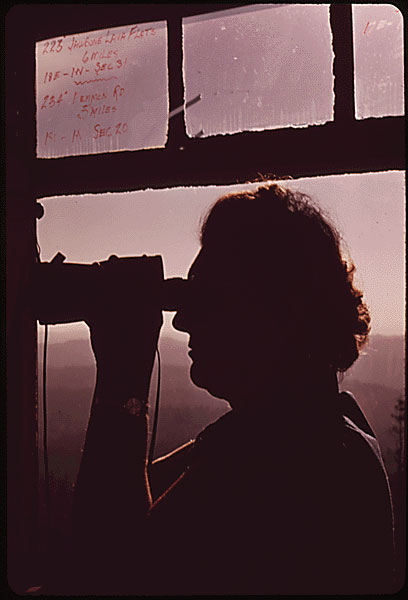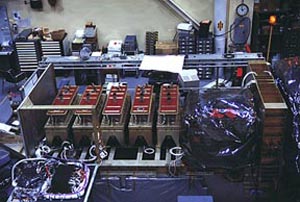X-ray Detectors Introduction
At its very heart, a telescope is a device to collect light from astronomical objects (like stars and galaxies) and deliver it to a detector. The detector's job is, then, to determine the direction, time of arrival, brightness, and intensity of the photons to the best of its ability.

Photo of a woman looking through a telescope. (Credit: Charles O'Rear/Environmental Protection Agency)
If you've ever had occasion to look through a telescope, then you, yourself, have been a detector. When you look through the eyepiece of a telescope, your eye becomes the detector of the incoming visible light. Historically, optical telescopes also used photographic plates and film as their detectors. Modern scientific telescopes use electronic detectors.
One big difference between optical detectors and high energy detectors (for X-ray or gamma-ray astronomy) is the number of photons they need to detect. Most optical sources put out a lot of photons, and large optical telescopes measure the flux (brightness over time) of the incoming light. X-ray detectors, on the other hand, usually detect individual X-ray photons – they measure each individual photon and then, over time, accumulate enough measurements to make an accurate picture of the total source.
It would be as if you looked at a white lightbulb and, instead of seeing white, saw a red photon, then a blue one, then a yellow one, then perhaps another red, then a green, and so on. After you had seen enough photons, you could combine them and say "Ah, I see, it's a white light."
In addition to determining the energy (or wavelength) of the incoming photons, a good detector also needs to provide precise timing information and precise positional information. This information allows astronomers to create light curves, perform timing analysis, and accurate images of the source. Timing information is crucial because many X-ray sources, such as pulsars, undergo changes on time scales much less than one second. Positional information is important to see where things are happening in a source – for example, if you are looking at a binary system, you would want to distinguish the two stars, and you need high spatial resolution of your detector to do that.
As mentioned in the introduction to X-ray telescopes, X-rays tend to pass right through most materials. That means that astronomers need to be careful to choose the right materials when making a detector. The point of a detector is to stop the incoming photon. If the X-rays pass right through the material, it's as if they were never there, as far as the detector is concerned. If the photons interact with the detector, losing some energy, but still make it out the other side, then the detector will incorrectly characterize those photons.
X-ray detectors, then, must be made of materials that X-rays will interact with. Those materials might be a gas that high energy photons will cause to "glow" or solid materials that will stop a high energy photon in its tracks. The detector size and materials must be designed so X-rays that enter are completely absorbed, producing some sort of signal in the process that you can measure.

Photo of the proportional counter array used on the Rossi X-ray Timing Explorer satellite. (Credit: NASA)
Detectors are designed so that incoming photons produce a signal that can take the form of an electric charge, light, or heat. Proportional counters and CCD (semiconductor) devices measure the electric charge that occurs when the incoming photon interacts with the detector's atoms and strips off electrons or causes photo-electrons to be emitted. Detectors such as scintillators measure the light produced when the photons interact with the atoms and are absorbed, producing photons (light) in return. Calorimeters do a direct measurement of the heat produced in the material when the incoming X-ray is absorbed.
A principal question with selecting a detector for a given application is to determine what your science goals are. One detector might be better at making an image of a source, recording detailed position information of the incoming light. Another detector might be better at measuring the spectrum of a source, which requires getting a very accurate measurement of the energy of each incoming X-ray. Still another detector might be better at recording timing information, measuring the exact time of arrival for each of the incoming X-ray photons. Ideally, a detector would be able to do all three of these: positional information, energy resolution, and timing information. In practice, detectors are optimized for one and are less capable of the others.
In the end, the best detector will depend on the job. And often, to get a complete picture of a cosmic object, astronomers will combine data from several different detectors.
Text updated: September 2018


